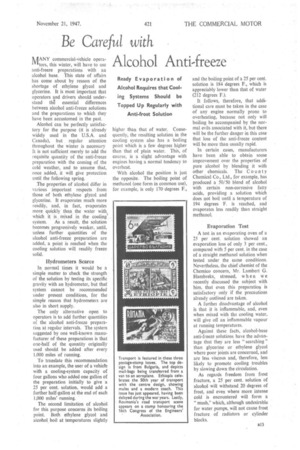Be Careful with Alcohol Anti-freeze
Page 47

If you've noticed an error in this article please click here to report it so we can fix it.
Ready Evaporation of Alcohol Requires that Cooling Systems Should be Topped Up Regularly with Anti-frost Solution
MANY commercial-Vehicle operators, this winter, will have to use anti-freeze preparations with an
alcohol base. This state of affairs has come about by reason of the shortage of ethylene glycol and glycerine. It is most important that operators and drivers should under stand the essential differences between alcohol anti-freeze solutions and the preparations to which they have been accustomed in the past.
Alcohol can be perfectly satisfactory for the purpose (it is already widely used in the U.S.A. and Canada), but regular attention throughout the winter is necessary It is not sufficient merely to add the requisite quantity of the anti-freeze preparation with the coming of the cold weather, and to assume that, once added, it will give protection until the following spring.
The properties of alcohol differ in various important respects from those of both ethylene glycol and glycerine. It evaporates much more readily, and, in fact, evaporates more quickly than the water with which it is mixed in the cooling system. As a result, the solution becomes progressively weaker, until, unless further quantities of the alcohol anti-freeze preparation are added, a point is reached when the cooling solution will readily freeze solid.
Hydrometers Scarce
In normal times it would be a simple matter to check the strength of the solution by testing its specific gravity with an hydrometer, but thaf system cannot be recommended under present conditions, for the simple reason that hydrometers are also in short supply.
The only alternative open to operators is to add further quantities of the alcohol anti-freeze preparation at regular intervals. The system suggested by one well-known manufacturer of these preparations is that one-half of the quantity originally used should be added after every 1.000 miles of running.
To translate this recommendation into an example, the user of a vehicle with a cooling-system capacity of four gallons who added one gallon of the preparation initially to give 'a 25 per cent. solution, would add a further half-gallon at the end of each ,000 miles'. running.
The second limitation of alcohol for this purpose concerns its boiling point. Both ethylene glycol and alcohol boil at temperatures slightly higher than that of water. Consequently, the resulting solution in the cooling system also has a boiling point which is a few degrees higher than that of plain water. This, of course, is a slight advantage with engines having a normal tendency to overheat.
With alcohol the position is just the opposite. The boiling point of methanol (one form in common use), for example, is only 170-degrees F., and the boiling point of a 25 per cent. solution is 184 degrees F., which is appreciably lower than that of water (212 degrees F.).
It follows, therefore, that additional care must be taken in the case of any engine normally prone to overheating, because not only will boiling be accompanied by the normal evils associated with it, but there will be the further danger in this case that loss of the anti-freeze content will be more than usually rapid.
In certain cases, manufacturers have been able to obtain some improvement over the properties of pure alcohol by blending it with other chemicals. The County Chemical Co., Ltd., for example, has produced a 50/50 blend of alcohol with certain non-corrosive fatty acids, providing a solution which does not boil until a temperature of 194 degrees F. is reached, and evaporates less readily than straight methanol.
Evaporation Test A test in an evaporating oven of a 25 per cent. solution showed an evaporation loss of only 3 per cent., compared with 5 per cent, in the case of a straight methanol solution when tested under the same conditions. Nevertheless, the chief chemist of the Chemico concern, Mr. Lambert G. Hambreks, stressed, when we recently discussed the subject with him, that even this preparation is satisfactory only if the precautions already outlined are taken.
A further disadvantage of alcohol is that it is inflammable, and, even when mixed with the cooling water, will give off an inflammable vapour at running temperatures.
Against these facts, alcohOl-base anti-freeze solutions have the advantage that they are less "searching" than glycerine or ethylene glycol where poor joints are concerned, and are less viscous and, therefore, less likely to promote cooling troubles by slowing down the circulation.
As regards freedom from frost fracture, a 25 per cent. solution of alcohol will withstand 20 degrees of frost, and even where more intense cold is encountered will form a "mush," which, although undesirable for water pumps, will not cause frost fracture of radiators or cylinder blocks.




















































































